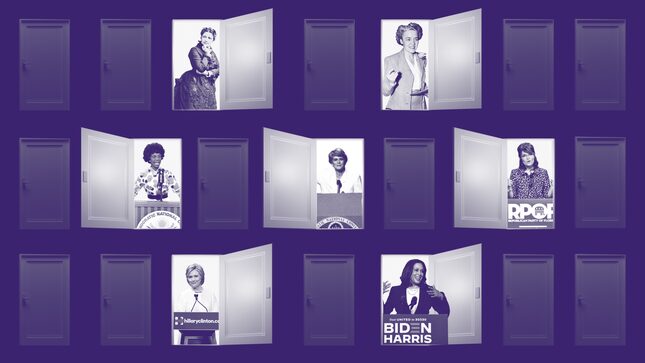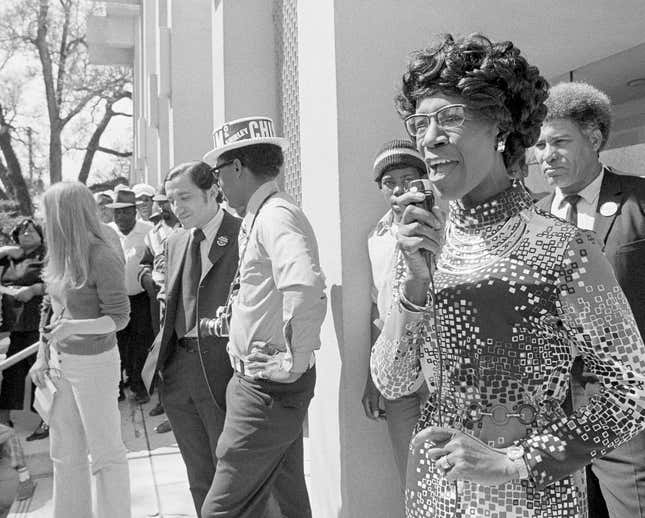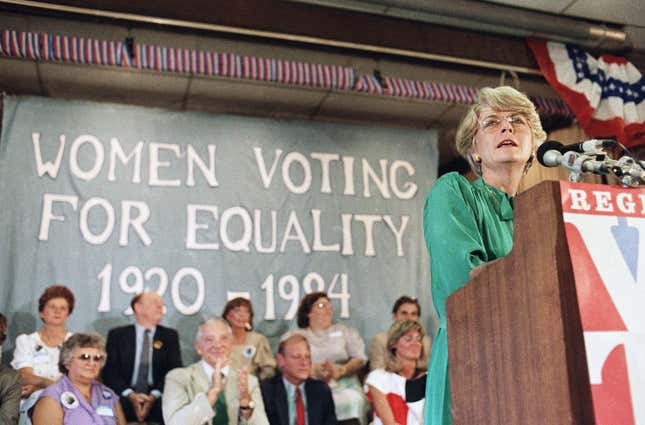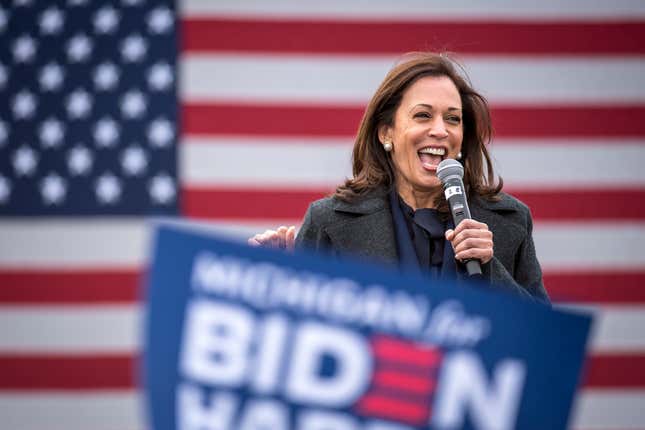Standing in the Doorway: The Dream of a Woman on a Winning Presidential Ticket
In Depth
Illustration: Elena Scotti (Photos: Getty Images)
I was determined to stick it out at the Jezebel offices on Election Day 2016—despite the fact that I was 36 weeks pregnant and my body felt like a wet sack of sand. I wanted to watch America elect its first woman president with my colleagues at this supposedly feminist website. Not as an unqualified victory for all women everywhere, but as an important landmark, nonetheless, one that I knew would bring a moment of collective euphoria. Quite simply, I wanted to witness history; I remembered the elation that had erupted in New York City when the 2008 election was called for Barack Obama, and I anticipated another symbolically important moment where the possibilities for the presidency expanded dramatically. I looked forward to watching America inaugurate its first woman president with my newborn daughter on my lap. Instead, when CNN called Florida for Trump, I went home, because it was clear that the 2016 election would be historic for entirely different reasons. The crash from the heights of anticipation was sharp, immediate, and painful.
Now we’re on the verge of another election; after beginning the Democratic primaries with a historically diverse slate of candidates, it’s once again a white man at the top of the ticket—but Kamala Harris is there, too, running as Joe Biden’s VP. And given that the man is 77 years old, she’s an important part of the proposition they are making to voters, charging around America in her Converses.
We’ve been here before; Harris is the third woman to run as VP on a major-party presidential ticket, and of course, previous presidential campaigns by women culminated in Clinton’s disastrous loss in 2016. All these years, and still no woman elected to either the top or the second-string spot—a dream that seems so close, yet constantly recedes into the distance. “A door has been opened that can never be closed again,” 1984 Democratic VP nominee Geraldine Ferraro said in her concession speech on the night she and her running mate, Walter Mondale, lost to Ronald Reagan in a blowout. The door may be open, but it’s proven nearly impossible to walk through. Now Harris stands on that threshold as a woman of color, giving her candidacy a spectacularly historic dimension—and attempts, once again, to pass through.
The history of women running for president goes back all the way to the 19th century before women even had a nationwide right to vote. The colorful Victoria Woodhull, a free love proponent, businesswoman, and spiritualist, among her many other qualities, ran in 1872 on a platform of equal rights and suffrage for women; she spent Election Day in jail on obscenity charges after accusing the prominent minister Henry Ward Beecher of adultery in her newspaper.
Senator Margaret Chase Smith of Maine, the first woman to serve in both houses of Congress, had a better run of it in her 1964 campaign, although she didn’t get very far, either. Smith initially found her way into politics when she ran to replace her husband, who died, in the House of Representatives. This was fairly common at the time: As a New Yorker piece explained: “Clyde Smith’s plea to his constituents drew upon a convention that emerged after women won the vote, in 1920—the “widow’s mandate,” which involved appointing or advancing by special election a woman to fill out the congressional term of a husband or other male relative.” The idea was that a wife would faithfully carry out her departed spouse’s agenda, without going rogue.
But for the motivated woman, it served as a doorway into a job that was tough to land on your own. Smith was one such woman, who continued her political career long after finishing out her husband’s term, and went on to serve in the Senate, where she was the sole woman. Smith was a conservative Republican and a Cold Warrior, though she voted for the Equal Rights Amendment and was also, famously, one of the rare Republicans to stand up to Joseph McCarthy at all. She was nationally known and respected almost as a kind of proto-Thatcher Iron Lady. She announced to her candidacy the National Women’s Press Club, beginning her speech by gesturing to the flower pinned to her jacket and joking, “I’m sorry to have disappointed you, but this was the freshest one I had on Monday morning.” She listed out all the reasons that she shouldn’t run—including resistance to a woman president—and said she was running to prove she could. Smith limited her campaigning to times when the Senate wasn’t in session and didn’t get much traction; she did, however, secure an official nomination on the convention’s floor by a longtime friend and fellow New Englander, securing her place in history.
Smith prided herself on her independence, but she was, nonetheless, an establishment figure, famous for her association with the Senate. Shirley Chisholm, on the other hand, ran in 1972 explicitly as a challenge to Democratic power brokers and their assumptions about which voters mattered. Her slogan: “Unbought and Unbossed.”

That independence, that explicit challenge, meant that Chisholm faced an uphill battle; she had trouble getting even women like Gloria Steinem and Bella Abzug to support her. She faced derision for even running at all: “She faced ridicule from the political and media establishment—and even the black press. ‘Woman President? It’s No Joke, Bub’ read one headline in the New York Amsterdam News. Walter Cronkite joked that “a new hat—rather, a bonnet” had just been thrown into the ring,” recounted Professor Anastasia Curwood in a piece about the Washington Post. It was open season on Chisholm, the left-wing Black woman, in a way it hadn’t been for Margaret Chase Smith. But she wasn’t running with the expectation of winning—she was running to demonstrate the importance of her supporters, people of color and women and the working class and the young. She wanted to “open the door ajar” for successors who weren’t white men, Curwood explains, and she succeeded. Chisholm was fearless and principled, and her legacy lives on in the modern left, in up-and-comers like the women of the Squad.
It was Geraldine Ferraro who first ran on a major-party ticket—and, ironically, it was the fact that she was a woman that helped get her there. Feminists had begun to organize around the idea of the “gender gap” between the Democrats and Republicans; a group of activists sat down and explicitly strategized how to get a woman on the Democratic ticket as VP, Smithsonian recounts. At this point, there were no women governors, and women were just a fraction of members of Congress, and there wasn’t a very deep bench of nationally known women. They settled on Ferarro, an up-and-coming Democratic congresswoman from Queens who offered the combination of tough and soft so often demanded from women in politics. She’d been a stay-at-home mom for a time before returning to work as a prosecutor, and she first ran for office with the slogan, “Finally, a tough Democrat.” She was maneuvered onto the ticket by feminist activists, with feminist goals—but she was seen as less aggressive, less threatening than somebody like Bella Abzug.
Walter Mondale, the candidate, agreed because he knew it was a steep climb to beat Reagan even if everything went well. A woman running mate could potentially disrupt the race. And so Ferraro took the stage at the DNC in an off-white dress that echoed the suffragettes, cut in the powersuit style of her own era, pairing big shoulders with a string of pearls and a no-nonsense Queens accent. Moments like fighting the wage gap and referencing the achievements of Sally Ride got huge applause from a proud and delighted crowd of women; the ERA got a full chant. “The issue is not what America can do for women, but what women can do for America,” she said.

One of the most iconic moments of her campaign came during the VP debate, when she faced off with former CIA head George H.W. Bush, who opened one of his answers with the condescending line, “Let me help you with the difference, Ms. Ferraro, between Iran and the embassy in Lebanon.” She responded bluntly: “Let me just say, first of all, that I almost resent Vice President Bush, your patronizing attitude that you have to teach me about foreign policy.” Bush in fact faced criticism at the time for talking down to the first woman VP candidate. Ultimately, Reagan stomped Mondale, but Ferraro and the activists who got her nominated had made their point.
The selection of Sarah Palin as John McCain’s running mate was a strategic choice meant to defuse the historic importance of Obama. The logic echoed that of Ferraro: the trends looked good for the opposition, so why not try a woman? Literally: In a 2008 New Yorker piece, Jane Mayer quoted a man named Adam Brickley, who helped put Palin on the radar as a possible VP for McCain; he started out by “randomly searching Wikipedia and elections sites for Republican women,” in hopes of finding the candidate a running mate who could make a difference. Only, 24 years after Ferraro, Palin represented a neat Republican trick in response to the successes of the women’s movement, borrowing feminist language to advance a vastly different agenda. Palin came to national prominence by casting herself as an outsider—a maverick to match McCain—and an important part of that performance was railing against the “old boys’ club,” in both Anchorage and D.C. But she was also relentless in performing a very specific form of femininity: She was a hockey mom, a “mama bear”—once again, that combination of toughness and acceptable maternity, in a slightly different blend for her Republican audience. When she faced off with the experienced Biden in their presidential debate—winking throughout—she delivered a rebuke similar to Ferraro’s, but cutesy, urging him: “Say it ain’t so, Joe!”
Finally, it was Hillary Clinton’s turn. After a lifetime spent in politics, waiting out her husband’s presidency, losing the primary to Obama in 2008, she landed the Democratic nomination. Her run in 2016 was framed as a culmination, with constant deployments of suffragette white. She was supposed to give a victory speech under the giant glass ceiling of New York’s Javits Center, confetti raining down in a symbolic gesture. Instead, she lost to a man who had mere weeks before been revealed on tape essentially bragging about sexual assault. Her resume was long, and she’d been patient—but she’d also been the target of constant Republican attacks for more than 30 years, turned into a larger-than-life villain for a huge portion of the electorate. They found her corrupt, they didn’t trust her, they just plain thought she seemed like a bitch. Clinton’s reputation goes all the way back to her arrival on the national political stage, when she outright announced that she wasn’t interested in playing the typical first lady role, saying she wasn’t the Tammy Wynette stand-by-your-man type of woman and she’d never wanted to stay home and bake cookies. Both of these remarks made the national news and kicked up huge controversy, and America has punished her for them ever since.
The 2020 Democratic primary launched with its most diverse field ever, but ultimately all the women dropped out to support the old, establishment white guy. No woman ever seems to be the right woman. She’s always too soft, or too aggressive, or just not quite the candidate, for reasons voters can’t or won’t name. The electorate has never taken Ferraro up on her offer to see what a woman can do for America. As a salve to the disappointment—and a strategic move—Joe Biden promised to select a woman as his running mate and ultimately chose Harris, someone with, like Ferraro, a background as a prosecutor. After trying to cast Biden as a socialist, Trump and his allies are instead portraying him as a weak man on the verge of dementia who will be led around by the “radical leftist” woman running as his VP. With their opponent a stubbornly middle-of-the-road white man, they want to make this election, in part, a referendum on whether the woman of color should be allowed to wield power.
And so here we are again, once again standing at the threshold of history. After decades of feminist activism, America has never elected a woman as either VP or president. In 1952, as part of an iconic campaign, Maidenform ran ads featuring a shirtless woman on a campaign stage, declaring, “I dreamed I won the election in my Maidenform bra.” American women have dreamed of stepping through this particular door for so long, only to meet with pushback over and over and over again. In 1995, a Walmart employee banished a t-shirt declaring “Someday a woman will be president” to the back of a store in suburban Miami, suggesting it violated the company’s “policy of political neutrality.” This story resurfaced in the 2016 campaign as a curiosity, the idea that it was a throwback to a less enlightened era. It was considered, in 2016, something of a foregone conclusion that a woman could, and would, be president.

And yet Clinton lost, casting a pall on the very possibility of that landmark, that collective euphoria. The stakes are so high, and the impact of the last four years so significant; this election is historic in so many ways that the possibility of a woman in the VP’s office is just one dimension of several. But that doesn’t make it any less important, and if Biden and Harris pull this off, she will have finally dragged us to the other side of a threshold we’ve been waiting on for so long. There would be poetic justice to its being Harris, an HBCU alum who stood on stage at the DNC and summoned the memory of Black women like Mary Church Terrell, Mary McLeod Bethune, and Fannie Lou Hamer, who fought so tirelessly for the vote, to hold America to its own national mythology.
And yet, after all these decades of hard work and near-misses, even if Joe Biden and Kamala Harris win, it won’t be a moment of euphoria and achievement, but rather one of relief—and short-lived relief, at that. If they win, they’ll inherit a mess, with the pandemic raging, the economy in free-fall, an obstructionist Republican party, an embolded and heavily armed white supremacist movement, and a judiciary tilted rightward for a generation, ready to frustrate any efforts to “Build Back Better.” The GOP will dig in and mold Kamala Harris into a left-wing villain, a monstrous witch. But she will have finally walked through the door—and absolutely nothing they can say or do will change that simple fact, the demonstration that it’s possible.